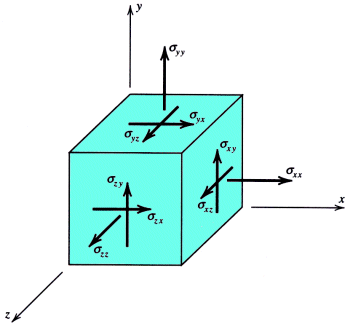introduction
aircraft, building, oil platform, mine, bioThe objective is to determine the largest stresses anywhere in the structure. No new theories are involved -- only applications of previously derived formulas and concepts.
axial σ = N/A torsion τ = Tc/J flexure s = -My/I shear τ = VQ/Ib pressure σ = pr/t
σ = pr/2tcombined σ = Σσi
τ = Στi
superposition
We will superimpose the stresses and strains caused by each load acting separately and then add those in the same direction,
σx = Nx/Ax + Fb/Ab + pr/t + pr/2t -p - Myy/Iy - Mzz/Iz
σy = Ny/Ay + Fb/Ab + pr/t + pr/2t -p - Mxx/Ix - Mzz/Iz
σz = Nz/Az + Fb/Ab + pr/t + pr/2t -p - Mxx/Ix - Myy/Iyτxy = V/A + Txcx/Jx + Tycy/Jy + VxQx/Ixbx+ VyQy/Iyby
τyz = V/A + Tycy/Jy + Tzcz/Jz + VyQy/Iyby+ VzQz/Izbz
τzx = V/A + Txcx/Jx + Tzcz/Jz + VxQx/Ixbx + VzQz/Izbzeliminating terms as needed.
method of analysis
- Select a point in the structure where the stresses and strains are to be determined. (usually where the stresses are the largest)
- For each load, determine the stress resultants at the point. (look at axial force, twisting moment, bending moment, shear force, pressure)
- Calculate the normal and shear stresses due to each stress resultant. (σ = P/A, τ = Tc/J, σ =My/I, τ = VQ/Ib, σ = pr/t)
- Combine the individual stresses. (obtain σx, σy, τxy at the point)
- Determine the principal stresses and maximum shear stresses.
- Determine the strains using Hooke's law.
- Repeat the process for additional points, until you are confident you have found the largest stresses anywhere in the structure



